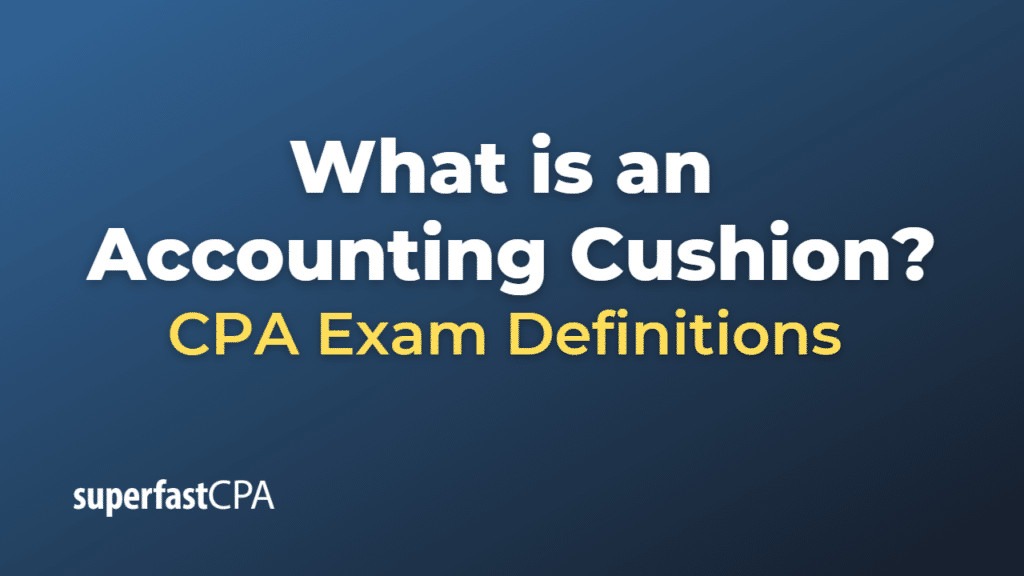Accounting Cushion
An accounting cushion, also known as an income smoothing or earnings management, is a practice used by companies to manipulate their financial results by using various accounting techniques to create a more stable and consistent earnings pattern over time. The goal of creating an accounting cushion is to present a more favorable financial picture of the company to investors, creditors, and other stakeholders.
Accounting cushions are created by making discretionary adjustments to revenues, expenses, and other financial statement items. These adjustments can be made within the bounds of generally accepted accounting principles (GAAP), but they may be considered aggressive or unethical if they result in a misleading representation of a company’s financial health.
Some common methods used to create accounting cushions include:
- Revenue recognition: A company may choose to defer revenue recognition to a future period if it wants to decrease its reported income in the current period, or it may accelerate revenue recognition if it wants to increase its reported income.
- Expense recognition: A company may choose to defer expense recognition to a future period if it wants to increase its reported income in the current period, or it may accelerate expense recognition if it wants to decrease its reported income.
- Bad debt provisions: A company may increase or decrease its allowance for doubtful accounts (bad debt provision) to manipulate its net income. By increasing the allowance, the company reduces its net income, while decreasing the allowance increases the net income.
- Depreciation and amortization: Companies can use different depreciation or amortization methods or change the estimated useful lives of assets to manipulate their reported earnings.
It’s essential to note that while some level of earnings management may be legal, it can lead to a distortion of a company’s true financial performance and mislead investors and other stakeholders. Excessive or fraudulent manipulation of financial results can result in legal consequences, damage to a company’s reputation, and a loss of investor confidence.
Auditors, regulators, and financial analysts play a crucial role in detecting and preventing the use of accounting cushions by scrutinizing financial statements, assessing accounting policies and estimates, and monitoring for unusual patterns in financial results.
Example of an Accounting Cushion
Let’s consider a fictional example of a manufacturing company called “StableTools” to illustrate the concept of an accounting cushion.
StableTools has a history of consistent growth in earnings, but during the current financial year, the company faces a temporary slowdown in sales due to a downturn in the market. To maintain the appearance of steady growth and meet investor expectations, StableTools’ management decides to use some accounting techniques to create an accounting cushion.
- Revenue recognition: StableTools has recently signed a large contract with a customer, and although the products have not been shipped and delivered yet, the company decides to recognize the revenue from the contract in the current financial year. This accelerates the revenue recognition and boosts the reported income for the year.
- Expense recognition: The company has incurred some significant repair and maintenance costs on its production equipment during the year. Instead of recognizing these costs as an expense in the current financial year, StableTools decides to capitalize the costs and depreciate them over the next few years. This defers the expense recognition and increases the reported income for the current year.
- Bad debt provisions: StableTools decides to decrease its allowance for doubtful accounts, assuming that its customers will be more likely to pay their outstanding balances. This reduction in the bad debt provision increases the company’s net income.
By using these accounting techniques, StableTools creates an accounting cushion that helps maintain the appearance of consistent earnings growth, despite the actual slowdown in sales. While some of these techniques may be within the bounds of generally accepted accounting principles (GAAP), they can be considered aggressive or misleading as they do not accurately represent the company’s true financial performance.
Investors, auditors, and financial analysts need to scrutinize StableTools’ financial statements, accounting policies, and estimates to identify potential manipulation and assess the company’s actual financial health. Using an accounting cushion to smooth earnings can lead to distorted financial reporting and may ultimately damage the company’s reputation and investor confidence if the true financial performance is revealed.













